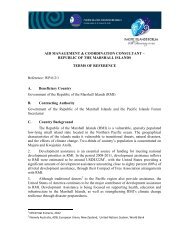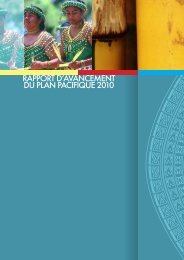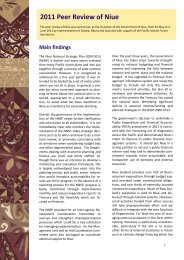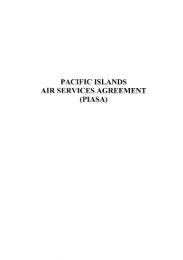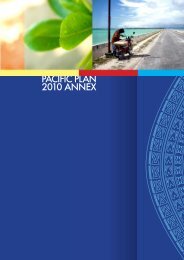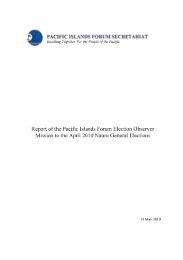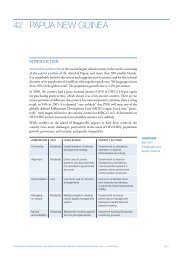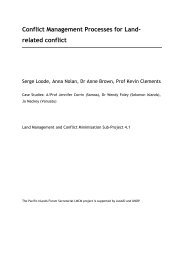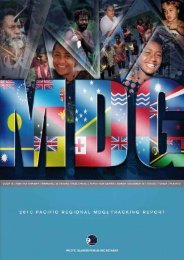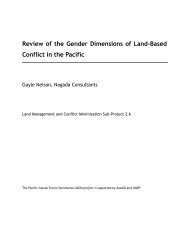Pacific Education Development Framework (PEDF) 2009-2015 - Pacific ...
Pacific Education Development Framework (PEDF) 2009-2015 - Pacific ...
Pacific Education Development Framework (PEDF) 2009-2015 - Pacific ...
You also want an ePaper? Increase the reach of your titles
YUMPU automatically turns print PDFs into web optimized ePapers that Google loves.
<strong>Pacific</strong> <strong>Education</strong> <strong>Development</strong> <strong>Framework</strong> (<strong>PEDF</strong>)<br />
<strong>2009</strong>-<strong>2015</strong><br />
Annex A
Background<br />
<strong>Pacific</strong> <strong>Education</strong> <strong>Development</strong> <strong>Framework</strong> (<strong>PEDF</strong>) 26 March <strong>2009</strong><br />
The first meeting of the Forum <strong>Education</strong> Ministers was held in May 2001 in Auckland, New Zealand.<br />
This initial meeting arose out of a recommendation from the Forum Economic Ministers (Apia, July<br />
1999) that the Leaders consider convening an ad hoc meeting of Forum Ministers of <strong>Education</strong> to review<br />
the results of some work commissioned in the area of human resource development. The Leaders<br />
subsequently (November 1999) directed that the <strong>Education</strong> Ministers meet to review the agenda prepared<br />
by the Economic Ministers.<br />
At the Auckland meeting Ministers were presented with the results of a range of evidence which<br />
highlighted that basic education systems in <strong>Pacific</strong> countries were failing the majority of young people<br />
and leaving them ill-prepared for dealing with their futures in either the formal or informal sectors of<br />
society. Ministers, in their deliberations, recognised that basic education is the fundamental building<br />
block for society. Ministers agreed to a <strong>Pacific</strong> Vision for education and to a number of goals including<br />
goals and commitments under the <strong>Education</strong> for All (EFA) framework. The key outcome of this meeting<br />
was the endorsement by Ministers of the Forum Basic <strong>Education</strong> Action Plan 2001 (FBEAP). The<br />
outcomes of subsequent Ministerial meetings were documented as updates or additions to the original<br />
FBEAP. In this way the FBEAP became a ‘living’ document.<br />
Following the initial FEdMM, at the Ministers request, the <strong>Pacific</strong> Islands Forum Secretariat (PIFS)<br />
sought funding for a project design for a regional initiative to facilitate the implementation of FBEAP<br />
within the region. The <strong>Pacific</strong> Regional Initiative for the Delivery of Basic <strong>Education</strong> (PRIDE) was<br />
launched in 2004 under funding from the EU and NZAID and became the major mechanism within the<br />
<strong>Pacific</strong> region for the implementation of FBEAP.<br />
In October 2005 the Forum Leaders endorsed the <strong>Pacific</strong> Plan with the goal of enhancing and stimulating<br />
economic growth, sustainable development, good governance and security for <strong>Pacific</strong> countries through<br />
regionalism. Improved education and training is one of the strategic objectives of the Plan in support of<br />
this goal. At their 2007 meeting, the <strong>Education</strong> Ministers decided that, given the seven years since<br />
FBEAP 2001, a comprehensive evaluation should be undertaken of FBEAP during 2008. A review of<br />
FBEAP was also seen as being able to contribute constructively to the <strong>Pacific</strong> Plan, also being reviewed<br />
in 2008.<br />
The extensive consultative process of the Review recommended a reborn regional plan with a new title.<br />
Following extensive discussion, and consideration by Ministers at the FEdMM in Tonga (March <strong>2009</strong>) it<br />
was agreed that the revised document be referred to as a framework, rather than an action plan.<br />
Accordingly an outcome of the Review is that the revised document be known as the <strong>Pacific</strong> <strong>Education</strong><br />
<strong>Development</strong> <strong>Framework</strong> (<strong>PEDF</strong>).<br />
<strong>Pacific</strong> <strong>Education</strong> <strong>Development</strong> <strong>Framework</strong> (<strong>PEDF</strong>) March <strong>2009</strong><br />
2
What the <strong>Framework</strong> is and how it can be used in the <strong>Pacific</strong> Region<br />
The idea of having a regional framework to guide the further development of <strong>Pacific</strong> education has been<br />
strongly supported by <strong>Pacific</strong> Forum countries through their education ministries. The approach also has<br />
the support of development partners. The <strong>PEDF</strong> will coordinate regional activities and provide advocacy<br />
and a leadership role in policy dialogue at the regional level. It will guide but not direct the work of<br />
Ministries at the national level.<br />
The framework is grounded in two sets of imperatives. First the commitments made by <strong>Pacific</strong> countries<br />
to global education calls for action and second, the national and regional response to the specific needs<br />
and challenges in respect of education in the <strong>Pacific</strong> region. The global commitments include the<br />
<strong>Education</strong> for All (EFA) agenda and goals, the Millennium <strong>Development</strong> Goals (MDGs) relating directly<br />
or indirectly to education, the United Nations Literacy Decade and also the UN Decade of <strong>Education</strong> for<br />
Sustainable <strong>Development</strong>. At the national level in most countries, these international commitments have<br />
been mainstreamed into the sectoral planning process. The challenges and needs that <strong>Pacific</strong> Island<br />
countries are experiencing as they attempt to bring about improvement in their education systems have<br />
been comprehensively analysed and documented as part of the review of FBEAP in 2008.<br />
What aspects of education and training does the <strong>PEDF</strong> cover? Based on the recommendations of the<br />
FBEAP Review, Ministers of <strong>Education</strong> have determined that the regional framework (<strong>PEDF</strong>) needs to<br />
address two broad agendas. First, the EFA or basic education agenda which covers the foundation of<br />
education, and second the training/employment/economic agenda. This second agenda was the genesis of<br />
the original meeting of <strong>Education</strong> Ministers through the referral from leaders on the basis of<br />
recommendations from Economic Ministers. It has recently been highlighted as a priority for <strong>Pacific</strong><br />
education and training systems by the Forum Leaders in their Niue communiqué. By being explicitly<br />
grounded in these two agendas the <strong>PEDF</strong> is well aligned with the <strong>Pacific</strong> Plan, a need also identified in<br />
the FBEAP Review. In this <strong>Framework</strong> basic education is interpreted in broad terms consistent with the<br />
common UNESCO usage (allowing countries to interpret/modify as appropriate to their own contexts).<br />
The framework embraces TVET in the widest sense. As a result the <strong>Framework</strong> includes all sectors of<br />
education with the exception of higher education.<br />
Implementing the <strong>Pacific</strong> <strong>Education</strong> <strong>Development</strong> <strong>Framework</strong> (<strong>PEDF</strong>)<br />
The <strong>PEDF</strong> is aligned with, and is grounded in, the core planning principles and concepts of the <strong>Pacific</strong><br />
Plan. As Improved <strong>Education</strong> and Training is one of the strategic objectives of the <strong>Pacific</strong> Plan, the<br />
<strong>PEDF</strong> supports the Leaders’ Vision of a region of peace, harmony, security and economic prosperity in<br />
which <strong>Pacific</strong> people can lead free and worthwhile lives.<br />
The <strong>PEDF</strong> reflects the <strong>Pacific</strong> concept of regionalism where countries work together for their joint and<br />
individual benefit. Regional aspects of the <strong>PEDF</strong> are designed to support and complement national<br />
programmes, not inhibit them. The justification for any regional strategies advocated in the <strong>PEDF</strong> is that<br />
they add value to national efforts. The <strong>PEDF</strong> identifies key priorities in each of the sub-sectors of<br />
education and training and also for each of a number of cross-cutting themes. These priorities which arise<br />
from international commitments such as the MDGs and EFA goals and the national education sector<br />
strategic frameworks have been documented in the FBEAP Review conducted in 2008. Accordingly the<br />
<strong>PEDF</strong> embraces a ‘bottom up’ approach to education sector development and planning, complemented by<br />
a ‘top down’ perspective based on global commitments and the regional <strong>Pacific</strong> Plan endorsed by the<br />
Forum Leaders. The <strong>PEDF</strong> addresses the special needs of Small Island States (SISs) which have been<br />
prioritised in the <strong>Pacific</strong> Plan and also the MDGs.<br />
<strong>Pacific</strong> <strong>Education</strong> <strong>Development</strong> <strong>Framework</strong> (<strong>PEDF</strong>) March <strong>2009</strong><br />
3
The <strong>Framework</strong> lays out a Vision, Mission and Strategic Goals for <strong>Education</strong> and Training in the <strong>Pacific</strong><br />
education and training based on the underlying imperative of quality education for all and ensuring access<br />
and equity in provision. The <strong>Framework</strong> has been developed as a matrix setting out for each Sub-sector<br />
and Cross-cutting Theme: Challenges and Priorities & Strategies. Challenges and Priorities have been<br />
identified and sourced from FBEAP as amended from 2001 to 2007 and the country and regional analyses<br />
conducted as part of the 2008 FBEAP review. Although the <strong>PEDF</strong> is a regional framework, the priorities<br />
specified are drawn from national priorities that are common across the region. All priorities endorsed by<br />
the FEdMM are identified and highlighted.<br />
The Targets specified are agreed targets as part of international commitments/conventions (e.g. EFA,<br />
MDGs) or, in specific cases, targets that have been set by <strong>Education</strong> Ministers through the FEdMM.<br />
Only in very specific circumstances is it appropriate to set regional targets for <strong>Pacific</strong> education given the<br />
wide variation in context and economic circumstances of the group of Forum countries. Where specific<br />
goals and targets have not been committed to, the <strong>Framework</strong> specifies high level ‘outcome statements’ to<br />
which national and regional effort will be directed.<br />
Monitoring and Evaluation of the <strong>Pacific</strong> <strong>Education</strong> <strong>Development</strong> <strong>Framework</strong><br />
The <strong>PEDF</strong>, consistent with the FBEAP and the <strong>Pacific</strong> Plan, is a ‘living document’ which will be subject<br />
to regular review and monitoring and systematic and comprehensive evaluation. Forum member<br />
countries through their <strong>Education</strong> Ministers will provide annually a country update on key developments<br />
against the <strong>Framework</strong> elements. If necessary, new elements to the framework will be added. Following<br />
consideration by Ministers, the <strong>PEDF</strong> will be amended to reflect these reports.<br />
An evaluation cycle will comprise two strands. Each year one of the Sub-sectors and one or two of the<br />
Cross Cutting Themes will be the subject of a <strong>Pacific</strong> ‘situation analysis’ with a view to identifying gaps<br />
and formulating proposals and strategies for possible regional action. The situation analyses will be<br />
undertaken by small working groups comprising representatives from Ministries and development<br />
partners. This will be an important capacity building exercise and will also encourage cross-fertilisation<br />
of ideas and sharing of experiences across the region. Following endorsement by Ministers, the<br />
framework will be amended to reflect these situation analyses. Over a 5 to 7 year cycle each key element<br />
of the <strong>Framework</strong> will as a result have been subject to a comprehensive evaluation. An independent<br />
review of the total <strong>Framework</strong> will be conducted every five years.<br />
<strong>Pacific</strong> <strong>Education</strong> <strong>Development</strong> <strong>Framework</strong> (<strong>PEDF</strong>) March <strong>2009</strong><br />
4
The <strong>Pacific</strong> <strong>Education</strong> <strong>Development</strong> <strong>Framework</strong><br />
Vision: Quality education for all in <strong>Pacific</strong> Island countries<br />
Mission: to enable each <strong>Pacific</strong> learner to develop all his/her talents and creativities to the full and<br />
thereby enabling each person to take responsibility for his/her own life and make a meaningful<br />
contribution to the social, cultural and economic development of <strong>Pacific</strong> society.<br />
Strategic Goals:<br />
1. To achieve universal and equitable participation and access to <strong>Pacific</strong><br />
education and training. (Access & Equity)<br />
2. To improve quality and outcomes. (Quality)<br />
3. To achieve efficient and effective utilisation of resources ensuring balanced<br />
and sustained development of <strong>Pacific</strong> education systems. (Efficiency &<br />
Effectiveness)<br />
Guiding principles and values: The <strong>PEDF</strong> is underscored by the following core of intrinsic and<br />
enduring values and principles:<br />
• <strong>Education</strong> as a human right: The human right to education is the foundation of the <strong>Pacific</strong><br />
<strong>Education</strong> <strong>Development</strong> <strong>Framework</strong>.<br />
• Holistic approach: By focusing on learning throughout life, the <strong>PEDF</strong> emphasises the links and<br />
pathways through the various stages or sub-sectors of education and the need to diversify these<br />
pathways to cater for the needs of all learners. This holistic approach is embraced in the four<br />
pillars of education from the UNESCO Jacques Delors report on The Treasure Within – learning<br />
to know, learning to do, learning to be and learning to live together. In the <strong>Pacific</strong> context these 4<br />
pillars are often contextualised as the ‘heads, hands, heart and soul’ paradigm of holistic lifelong<br />
learning.<br />
• Diversity: mutual respect and valuing of the differences within and between <strong>Pacific</strong> societies<br />
cultures and values.<br />
• Harmonisation: a shared commitment between countries and development partners to align<br />
development activities with partner countries' national priorities; and giving importance to the<br />
national leadership role in coordinating development assistance with a focus on managing for<br />
results.<br />
• Partnerships: <strong>Education</strong> and training involves governments, parents, teachers, students,<br />
community organisations and development partners. This <strong>PEDF</strong> is based on recognition that<br />
<strong>Pacific</strong> learners will not reach their potential if governments and key stakeholders work in<br />
isolation from each other. Encouraging and sustaining meaningful partnerships in education is<br />
central to realisation of the <strong>Framework</strong>’s Vision.<br />
<strong>Pacific</strong> <strong>Education</strong> <strong>Development</strong> <strong>Framework</strong> (<strong>PEDF</strong>) March <strong>2009</strong><br />
5
SSE1: EARLY CARE & CHILDHOOD EDUCATION (ECCE)<br />
High quality ECCE programmes can benefit countries by promoting cognitive performance of young children,<br />
increasing the efficiency of primary and secondary education, contributing to future productivity and income,<br />
reducing costs of health and other public services, reducing gender inequities and increasing female<br />
participation in the labour force. Although the research base is still relatively thin, particularly in the <strong>Pacific</strong><br />
context, existing relevant studies do indicate a high social return on investment in ECCE. Studies have shown<br />
that attendance at some form of preschool is a key determinant of the likelihood of completion of primary<br />
schooling. The further development of ECCE is a key priority of the <strong>PEDF</strong>. This is the initial access point to<br />
lifelong learning.<br />
Goals/targets: EFA Goal 1: Expanding and improving comprehensive early childhood care and education,<br />
especially for the most vulnerable and disadvantaged children.<br />
Challenges Priorities and Strategies<br />
Access: Although significant progress has been made in<br />
the region in recent years, the Gross Enrolment Ratio<br />
(GER) is less than 60% in several countries meaning<br />
many young children still are not receiving any ECCE.<br />
Equity: Children from rural areas and those living in<br />
poverty are under-represented in ECCE enrolments.<br />
High proportion of female teachers encourages gender<br />
stereotypes.<br />
Quality: Many teachers have little formal ECCE training;<br />
requirements as to what constitutes a qualified ECCE<br />
teacher vary considerably across the region; teachers are<br />
generally poorly paid.<br />
There are very few purpose-built facilities, particularly in<br />
rural areas.<br />
Policy and administration: Government support is often<br />
problematic since the ECCE sector is not generally seen<br />
as part of basic education.<br />
Knowledge of this sector amongst key stakeholders is<br />
often weak and limited.<br />
Responsibility for the 0-3 year old children is usually<br />
unclear, increasing the vulnerability of this group.<br />
Several countries are yet to develop an ECCE policy.<br />
Lack of accurate disaggregated data on the sub-sector;<br />
data systems require considerable development.<br />
There is a lack of evidence-based research and studies on<br />
ECCE in the <strong>Pacific</strong>.<br />
<strong>Pacific</strong> <strong>Education</strong> <strong>Development</strong> <strong>Framework</strong> (<strong>PEDF</strong>) March <strong>2009</strong><br />
Access & Equity: Expansion of the sector to<br />
improve access particularly for vulnerable and<br />
disadvantaged children<br />
Focus on inclusion and equity in further<br />
development of the ECCE sector.<br />
Quality: Implementation of comprehensive<br />
quality ECCE programmes grounded in local<br />
cultures and languages. (FEdMM endorsed<br />
priority, 2007)<br />
<strong>Development</strong> of learning and development<br />
standards for ECCE curriculum.<br />
<strong>Development</strong> of good quality teaching and<br />
learning resources.<br />
Improvement in remuneration and conditions for<br />
ECCE teachers.<br />
Further development and strengthening of ECCE<br />
teacher training regionally and nationally.<br />
Efficiency & Effectiveness: <strong>Development</strong> of<br />
coherent and holistic national policy and planning<br />
frameworks for the development of the<br />
sector.(FEdMM endorsed priority, 2007)<br />
Clarification of government roles and<br />
responsibilities.<br />
Establishment of coordinating bodies at national<br />
level to provide leadership for development of<br />
the sector.<br />
Establishment and strengthening of crosssectoral<br />
partnerships with relevant Ministries and<br />
NGOs working in the ECCE sector<br />
Strengthening of partnerships and increase in<br />
community participation in the ECCE sector.<br />
Note: ECCE is apriority area under PRIDE<br />
6
SSE 2: FORMAL SCHOOL EDUCATION (PRIMARY AND SECONDARY)<br />
The first 9 or 10 years of formal schooling forms the core of basic education. Formal schooling needs to be<br />
available to all young people for growth and development to be inclusive. Without this foundation, no society<br />
can develop effectively. Not only must school education be universally accessible, it also must be of high<br />
quality, relevant, and sustainable to equip citizens to improve society and to benefit from social and economic<br />
progress. Accessible school education of high quality provides the foundation for continuous and lifelong<br />
learning. The further development of quality formal school education which is accessible to all children and<br />
provided equitably and in a sustainable way is a core strategy of the <strong>PEDF</strong>.<br />
Goals/targets: EFA Goal 2: Ensuring that by <strong>2015</strong> all children, with special emphasis on girls and children in<br />
difficult circumstances and from ethnic minorities have access to and complete free and compulsory primary<br />
education of good quality.<br />
EFA Goal 5: Eliminating gender disparities in primary and secondary education by 2005, and achieving<br />
gender equality in education by <strong>2015</strong>, with a focus on ensuring girls’ full and equal access to and achievement<br />
in basic education of good quality.<br />
EFA Goal 6: Improving all aspects of the quality of education and ensuring excellence for all, so that<br />
recognised and measurable learning outcomes are achieved, especially in literacy, numeracy and essential life<br />
skills.<br />
MDG 2: Achieve Universal Primary <strong>Education</strong><br />
Target 3<br />
Ensure that, by <strong>2015</strong>, children, everywhere, boys and girls alike, will be able to complete a full course of<br />
primary education<br />
Indicators<br />
Net enrolment rate in primary education; Proportion of pupils starting grade 1 who reach grade 5; Literacy rate<br />
of 15-24 year olds<br />
MDG 3: Promote gender equality and empower women<br />
Indicator: Ensure that, by <strong>2015</strong>, children everywhere, boys and girls alike, will be able to complete a full<br />
course of secondary schooling.<br />
Challenges Priorities & Strategies<br />
Access: All of the countries in the <strong>Pacific</strong> region are experiencing<br />
access challenges of some sort.<br />
The first access challenge is to ensure that all children enrol in<br />
school in the early stages of formal education. The second<br />
challenge is to reduce the high rates of student dropout which are<br />
common in most countries.<br />
Equity: Under-representation of girls in student enrolment remains<br />
a challenge in the Melanesian countries although gaps are<br />
generally closing. In most of the other <strong>Pacific</strong> countries close to<br />
gender parity has been achieved in compulsory education.<br />
Females are generally under-represented in upper secondary<br />
education.<br />
Most PICs are being challenged by boys’ underachievement.<br />
A key challenge is providing an equitable education to students in<br />
remote and isolated areas. Issues associated with this challenge are<br />
high cost of provision, difficulties in attracting and retaining<br />
teachers to the rural areas and poor quality of resources, transport<br />
and infrastructure.<br />
Quality: Despite the achievements that have been made in sector<br />
<strong>Pacific</strong> <strong>Education</strong> <strong>Development</strong> <strong>Framework</strong> (<strong>PEDF</strong>) March <strong>2009</strong><br />
Access: The achievement of universal<br />
basic education is the first priority of<br />
several countries. Where there is a<br />
current significant shortfall, countries<br />
(PNG, Solomon Islands and Vanuatu)<br />
have identified closing this gap as a<br />
major priority. Several countries are<br />
addressing this access gap through<br />
World Bank EFA Fast Track Initiative<br />
Further development of opportunities for<br />
flexible, open and distance learning to<br />
reach those who have been unable to<br />
access formal schooling to date.<br />
Equity: Priorities include participation<br />
of girls in upper secondary; development<br />
of research strategies to improve the<br />
educational performance of boys;<br />
development and implementation of<br />
cost-effective strategies for service<br />
delivery to remote and outer island<br />
7
development, most <strong>Pacific</strong> countries continue to experience the<br />
challenge of achieving sustainable improvement in quality of<br />
education.<br />
The critical input in quality of education in the <strong>Pacific</strong> is teacher<br />
quality. All countries have critical challenges in terms of teacher<br />
and head teacher/school principal competence. Commitment of<br />
teachers and principals in terms of leadership remains a major<br />
challenge<br />
High levels of teacher absenteeism in some countries is a clear<br />
indication of a need that countries have to strengthen teacher and<br />
principal accountability frameworks.<br />
Many students are finishing school with inadequate basic literacy,<br />
numeracy and life skills. Others leave school before the proper<br />
acquisition of these skills.<br />
Countries generally have weak capacity in assessment and test<br />
development.<br />
Literacy and numeracy tests administered in a number of countries<br />
in primary schools indicate continuing problems with literacy with<br />
the number of ‘at risk’ students in English in excess of 40 %. The<br />
results of these tests indicate that girls are outperforming boys<br />
consistently and this is another challenge in most countries.<br />
The school curricula, despite attempts at redevelopment to meet<br />
vocational and life skill needs, generally remain largely academic<br />
and do not fully meet needs of all <strong>Pacific</strong> students. Curriculum<br />
frameworks are either non-existent or at early stages of<br />
development.<br />
The poor state of the physical learning environment of schools and<br />
classrooms including textbooks, classroom learning materials,<br />
libraries, ICT tools and the lack of maintenance of school buildings<br />
and infrastructure, represent a major challenge.<br />
This challenge is linked to the issue of sustainable financing of<br />
education systems and the structure of education outlays in which<br />
for most systems salaries represent over 90% of recurrent budgets.<br />
Health and education: Increases in non-communicable diseases are<br />
threatening the lifestyles of <strong>Pacific</strong> communities and many young<br />
people in school. The links between the education and health<br />
sectors are weak and need strengthening.<br />
<strong>Pacific</strong> <strong>Education</strong> <strong>Development</strong> <strong>Framework</strong> (<strong>PEDF</strong>) March <strong>2009</strong><br />
communities.<br />
Quality: Investing in teacher quality<br />
needs to be the highest priority<br />
investment for <strong>Pacific</strong> countries to<br />
improve their education systems.<br />
Key specific priorities for many<br />
countries in addressing the quality<br />
challenge are the development of teacher<br />
and principal accountability frameworks<br />
and standards and development of<br />
ongoing and sustainable programs for inservice<br />
training of teachers and school<br />
leaders. FEdMM endorsed (2006)<br />
partnership involving<br />
UNESCO,UNICEF,SPBEA and PRIDE<br />
is developing regional benchmarks in<br />
literacy, numeracy and life-skills. These<br />
benchmarks to be used for monitoring<br />
quality of education at country and<br />
regional levels.<br />
Comprehensive curriculum review and<br />
redevelopment (including development<br />
of curriculum and assessment<br />
frameworks) is one of the top priorities<br />
in current educational plans in more than<br />
half of the countries. Central to these<br />
reviews is the emphasis being placed on<br />
language and culture and rethinking of<br />
education policy and practice. FEdMM<br />
endorsed priority (2001 & 2005) to<br />
focus on governance and<br />
entrepreneurship in curriculum<br />
reviews.<br />
Further priorities are:<br />
Capacity building in Ministries in test<br />
development and implementation.<br />
Implementation of standards based<br />
assessment in schools based on defined<br />
learning outcomes.<br />
<strong>Development</strong> of assessment frameworks<br />
at the national level, in line with<br />
curriculum frameworks. (FEdMM<br />
endorsed priority 2004)<br />
Physical learning environment:<br />
upgrading of classrooms which provide<br />
a sub-standard educational environment<br />
for teaching and learning.<br />
Strengthening of initiatives in promoting<br />
the active involvement of the school<br />
community in the affairs of schools in<br />
order to enhance the quality of facilities<br />
and teaching-learning resources.<br />
(FEdMM priority, 2001)<br />
8
<strong>Pacific</strong> <strong>Education</strong> <strong>Development</strong> <strong>Framework</strong> (<strong>PEDF</strong>) March <strong>2009</strong><br />
Efficiency & Effectiveness: A key<br />
priority (FEdMM endorsed 2006) is<br />
continued advocacy for closer<br />
collaboration between education and<br />
health and strengthening of the linkages<br />
between health and education Ministries<br />
at the national level and between<br />
relevant bodies at regional level.<br />
Note: Across many of these identifies<br />
priority areas PRIDE has been the<br />
main regional vehicle for<br />
implementation in this sub-sector.<br />
9
SSE 3: TECHNICAL & VOCATIONAL EDUCATION & TRAINING (TVET) The development of skills has been<br />
highlighted repeatedly by Forum <strong>Education</strong> Ministers and also by Forum leaders, most recently in the 2008<br />
Niue communiqué. The <strong>Pacific</strong> Plan emphasises the need to strengthen and expand national and, where<br />
appropriate, regional vocational educational and training programs. Despite the importance of TVET for social<br />
and economic development, national governments and regional organisations and development partners in the<br />
<strong>Pacific</strong> have, until recently, tended to give less emphasis to TVET relative to the other sub-sectors of education.<br />
The further development of this sector is crucial to addressing the needs of a rapidly growing youth cohort and<br />
creating conditions for further economic growth. Strengthening of TVET’s responsiveness to both the needs of<br />
the formal and informal sectors is now a high regional priority. The identification of challenges and priorities<br />
for this sub-sector draws heavily on the recently completed ADB/PIFS study, Skilling the <strong>Pacific</strong>.<br />
Goals/targets<br />
EFA Goal 3: Ensuring that learning needs of all young people and adults are met through equitable access to<br />
appropriate learning and life skills programmes.<br />
No specific agreed TVET targets but imperatives from <strong>Pacific</strong> Plan and Niue Leaders (2008) communiqué<br />
highlight priority for development of the TVET sector.<br />
Outcomes to be achieved:<br />
The supply of skills supplied by <strong>Pacific</strong> TVET systems responds to meet the needs of the informal sector and<br />
the changing labour market demands in the formal sector.<br />
Challenges Priorities & Strategies<br />
Access and equity:<br />
Across the region, access to organised skills development is<br />
relatively low in relation to the number of school leavers. Lowerincome<br />
groups, and those in rural areas and outer islands, tend to<br />
have much less access to skills development. Girls and women in<br />
particular tend to be under-enrolled in TVET, or concentrated in<br />
traditional female occupations.<br />
Quality: Training systems tend to operate in isolation of labour<br />
market demand and with little or no employer participation.<br />
In most countries the ingredients for quality - occupational<br />
standards, qualified instructors, necessary equipment, and quality<br />
assurance mechanisms – are lacking. Poor educational attainment<br />
of incoming trainees is limiting skill achievements.<br />
Significant gaps exist in the level of skills, knowledge and<br />
experience of teachers and work-based instructors. There are also<br />
shortfalls in the number and qualifications of instructors.<br />
Infrastructure, equipment and materials also tend to be inadequate<br />
and need upgrading. Quality assurance processes are generally<br />
weak, including skills-testing systems. Accreditation systems and<br />
processes for private training providers are weak. Monitoring and<br />
evaluation of the quality TVET outcomes in terms of competencies<br />
achieved is another critical weakness.<br />
Policy, planning and organisation: The ADB/PIFS Skilling the<br />
<strong>Pacific</strong> study found that TVET is the most difficult sub-sector to<br />
organise and manage in the education sector.<br />
Unclear central agency roles hamper the sector. In a number of<br />
<strong>Pacific</strong> countries several line ministries, such as the ministries of<br />
education and labour, have overlapping or uncoordinated<br />
responsibilities for TVET. Responsibilities of the various<br />
supervisory organisations tend to be ill defined. Fragmented and<br />
uncoordinated provision of informal sector training limits effective<br />
<strong>Pacific</strong> <strong>Education</strong> <strong>Development</strong> <strong>Framework</strong> (<strong>PEDF</strong>) March <strong>2009</strong><br />
Two priorities are shared across the<br />
region: quality improvement and<br />
organisational development. The<br />
principal initial priority for quality<br />
improvement is establishment of<br />
vocational qualification frameworks.<br />
The priority for organisational<br />
development is the establishment/<br />
strengthening of apex training<br />
organisations and national qualifications<br />
authorities.<br />
Other priorities include addressing the<br />
neglect in training for the informal sector;<br />
establishment of minimum of standards<br />
for TVET providers and development of<br />
accreditation and audit arrangements for<br />
monitoring of standards.<br />
Enhancement of the role, status and<br />
development of TVET at national level<br />
and mobilisation of resources to enhance<br />
wider understanding and acceptance of<br />
TVET in the region (FEdMM endorsed<br />
priority 2005)<br />
There is a clear need to increase public<br />
and private investment in TVET and to<br />
diversify financing instruments.<br />
A further priority is the development of a<br />
Regional Qualifications Register and<br />
subsequently a Regional Qualifications<br />
<strong>Framework</strong> (FEdMM endorsed 2001<br />
and 2005).<br />
10
use of resources. Key TVET organisations, particularly national<br />
training councils, often lack the resources to carry out their<br />
functions.<br />
Lack of data and research on TVET is an impediment to progress.<br />
Managers of institutions lack authority and incentives to improve<br />
performance.<br />
Training for the informal sector where the majority of <strong>Pacific</strong><br />
peoples live and work has tended to be particularly neglected.<br />
<strong>Pacific</strong> <strong>Education</strong> <strong>Development</strong> <strong>Framework</strong> (<strong>PEDF</strong>) March <strong>2009</strong><br />
The Skilling the <strong>Pacific</strong> Study was<br />
commissioned by ADB and PIFS with<br />
Ministerial mandate to fill the knowledge<br />
and evidence gap regarding TVET and its<br />
linkage with <strong>Pacific</strong> and global labour<br />
markets.<br />
The report of the study released in 2008<br />
sets out a number of priority areas for<br />
action at both national and regional level.<br />
Project proposals based on the study have<br />
been developed (for consideration under<br />
EU funding) focused on i) NFE TVET; ii)<br />
Institutional development of TVET; iii)<br />
strengthening of labour market<br />
information; quality assurance systems<br />
and processes.<br />
11
SSE 4: NON-FORMAL EDUCATION (NFE): Non-formal education in <strong>Pacific</strong> countries preceded the<br />
establishment of formal systems and as such this sub-sector has a legitimacy of its own and is not dependent for<br />
its energy and quality on government standard setting processes. NFE may also take place within formal<br />
education and training institutions. The sub-sector caters to persons of all ages. NFE does generally not lead to<br />
some form of accreditation. However issues of access, equity and quality are important for NFE, and the sub<br />
sector is pivotal in terms of lifelong learning and attainment of EFA Goals pertaining to literacy and life skills<br />
and also the non formal aspects of TVET. Although the main focus of PRIDE has been the formal sectors, NFE<br />
is a key strategy in realising the vision of the <strong>Pacific</strong> Plan and as such is an important component of the <strong>PEDF</strong>.<br />
Goals/targets:<br />
EFA Goal 3: Ensuring that learning needs of all young people and adults are met through equitable access to<br />
appropriate learning and life skills programmes.<br />
EFA Goal 4: Achieving a 50% improvement in levels of adult literacy by <strong>2015</strong>, especially for women, and<br />
equitable access to basic and continuing education for all adults.<br />
Challenges Priorities & Strategies<br />
Access & Equity: Data on participation in the NFE sector is<br />
patchy. However it is clear that NFE programmes offer an<br />
important pathway out of poverty for many women and<br />
disadvantaged target groups.<br />
Quality: A key challenge for NFE in the <strong>Pacific</strong> is development of<br />
appropriate quality assurance mechanisms that take in to account<br />
the unques features of the NFE sub sector.<br />
There is a need for some pathways to be developed for learners to<br />
move between the non-formal and formal sectors.<br />
Policy, coordination and capacity: It is recognised that the<br />
private sector including traditional structures plays the major role<br />
in provision of NFE independent of government control. Policies<br />
on NFE in the <strong>Pacific</strong> are lacking in most countries. The<br />
development of policies needs to address the relations amongst<br />
providers while safeguarding the special nature of individual<br />
providers. At the same time policies need to be linked to national<br />
development strategies and plans, resource allocations and other<br />
commitments.<br />
<strong>Pacific</strong> <strong>Education</strong> <strong>Development</strong> <strong>Framework</strong> (<strong>PEDF</strong>) March <strong>2009</strong><br />
Access & Equity: Expansion of literacy<br />
programs for adults, especially women<br />
and out of school youth.<br />
Quality: <strong>Development</strong> of appropriate<br />
quality assurance systems and processes.<br />
Active promotion of community<br />
awareness on the importance of <strong>Pacific</strong><br />
culture, language and identity in NFE<br />
programme development.<br />
Efficiency & Effectiveness: Overall<br />
policy and strategy development for the<br />
NFE sector<br />
<strong>Development</strong> of agreed coordinating<br />
structures that recognise there are different<br />
levels and categories of non-formal<br />
education.<br />
Strengthening of partnerships with and<br />
among NGOs to ensure that they are at the<br />
forefront of delivery of NFE.<br />
Capacity development and training of staff<br />
in NFE at both national and regional level.<br />
Where income generation is the focus of<br />
NFE, policies and strategies for<br />
identification and strengthening of<br />
markets.<br />
12
SSE 5: TEACHER DEVELOPMENT: IN -ERVICE EDUCATION AND PRE-SERVICE EDUCATION OF TEACHERS;<br />
ENHANCING THE STATUS OF THE TEACHING PROFESSION<br />
There is a substantial body of research internationally which affirms that quality education is not possible without<br />
quality teaching. Teachers are at the heart of every education system, and plans and strategies for the initial<br />
preparation and ongoing professional development of teachers are central elements of the process and dynamic of<br />
achieving goals and targets relating to quality, access and equity in education. This area requires close partnerships<br />
between ministries and teacher training providers. Regional strategies are necessary in the <strong>Pacific</strong> to support national<br />
strategies in teacher development.<br />
Goals/targets: No specific goals or targets set or endorsed by Forum <strong>Education</strong> Ministers. Most national<br />
governments have set minimum requirements or standards for pre-service training. A number of countries are<br />
considering standards for ongoing professional development.<br />
Outcomes to be achieved:<br />
Sufficient numbers of appropriately trained and qualified teachers and trainers available in <strong>Pacific</strong> education &<br />
training systems.<br />
Sustainable programs of lifelong learning for teachers and trainers implemented and monitored.<br />
The teaching profession is valued by the community and attracts people with appropriate skills, attitudes and values.<br />
Challenges Priorities<br />
Supply and qualifications of teachers: There is a growing shortage<br />
of qualified teachers in the <strong>Pacific</strong>. Several countries have a backlog<br />
of untrained teachers.<br />
Pre-service education: Resourcing of many teacher training<br />
institutions is far from adequate. Quality and capacity issues are<br />
critical challenges.<br />
Teacher education is still heavily influenced by colonial mindsets.<br />
<strong>Pacific</strong> pedagogies need to be developed and encouraged. Aid<br />
dependency is still very strong in the pre service training of teachers.<br />
In-service training: The teaching service is ageing and many<br />
teachers have had insufficient professional development opportunities<br />
to keep up to date with teaching requirements.<br />
Many countries have remote islands and face severe logistical<br />
challenges and high cost of bringing teachers to in-service training.<br />
Historical under funding of ISE programs: Many teachers are<br />
receiving little, if any, ISE in their first five years of teaching.<br />
Strengthening the status of teaching as a profession is a critical<br />
challenge in all <strong>Pacific</strong> countries.<br />
The need to strengthen school leadership and the professional<br />
qualities of principals is a critical challenge across all <strong>Pacific</strong><br />
countries.<br />
<strong>Pacific</strong> <strong>Education</strong> <strong>Development</strong> <strong>Framework</strong> (<strong>PEDF</strong>) March <strong>2009</strong><br />
Quality: Upgrading of pre-service training<br />
programmes, staffing and resources at<br />
national and regional training institutions.<br />
Induction for beginning teachers to be<br />
formalised.<br />
Upgrading programmes for partially trained<br />
teachers.<br />
<strong>Development</strong> of sustainable programmes of<br />
in-service education based on country needs<br />
analyses.<br />
<strong>Development</strong> of innovative strategies using<br />
ICT and distance learning.<br />
Enhancing the professional status of teaching<br />
Further development of professional<br />
standards of practice.<br />
More selective recruitment of teacher<br />
trainees.<br />
<strong>Development</strong> of viable <strong>Pacific</strong> teacher<br />
education models that link theory, practice<br />
and research.<br />
<strong>Development</strong> of initiatives to incorporate<br />
indigenous approaches to teacher education.<br />
Efficiency & Effectiveness: Strengthening of<br />
existing national data bases to generate<br />
teacher supply and demand projections<br />
Planning for the implementation (as part of<br />
sector wide programs) of training all<br />
untrained teachers as soon as practicable.<br />
Improved coordination and communication<br />
between ministries of education and teacher<br />
training institutions.<br />
<strong>Development</strong> of regional protocol for teacher<br />
recruitment (FEdMM 2005).<br />
13
SSE 6: SYSTEM GOVERNANCE & ADMINISTRATION<br />
<strong>Education</strong> by its nature is acknowledged as a very intensive user of human and financial resources. The goals<br />
set for the education sector and the strategies to be followed therefore need to be well integrated with national<br />
planning policies and planning frameworks. Strengthened governance, planning and policy frameworks are an<br />
essential requirement for sustained improvement in <strong>Pacific</strong> educational outcomes. <strong>Pacific</strong> countries are<br />
working closely with development partners to improve the quality of system governance and administration<br />
and the efficiency and effectiveness of development assistance.<br />
Goals/targets: The Paris Declaration on Aid Effectiveness (2005) has the commitment of the major<br />
development partners working in education in the <strong>Pacific</strong> and has been formally endorsed by seven <strong>Pacific</strong><br />
countries, with other countries supporting the declaration in principle. The declaration commits signatories to<br />
support actions in aid management which are based on five core principles: ownership, alignment,<br />
harmonisation, managing for results and mutual accountability<br />
MDG 8: Develop a Global Partnership for <strong>Development</strong><br />
Targets: Address the special needs of landlocked and small island developing states.<br />
In cooperation with the private sector, make available the benefits of new technologies, especially information<br />
and communication technologies.<br />
Challenges Priorities & Strategies<br />
Sector planning, donor harmonisation and aid management:<br />
Some countries particularly the Small Island States need further<br />
assistance with capacity development in education sector planning,<br />
policy development, research and policy analysis, performance<br />
indicator development, costing and development of medium term<br />
expenditure frameworks.<br />
Effective management of donor resources remains a key challenge<br />
in most <strong>Pacific</strong> countries. Countries require capacity development<br />
in sector planning and monitoring consistent with their enhanced<br />
roles and responsibilities under the Paris Declaration.<br />
Finance for education: Securing sustainable finance for education<br />
is a major challenge. Most governments have made significant<br />
commitments reflected in the high share of government spending<br />
allocated to education and also education’s share of GDP which is<br />
high in the <strong>Pacific</strong> compared to other regions. There are major<br />
challenges in the structure of education budgets, with a very high<br />
proportion allocated to salaries, the relatively small allocations to<br />
TVET and NFE and the narrow range of revenue sources.<br />
Monitoring & Evaluation and <strong>Education</strong> Management<br />
Information Systems (EMIS)<br />
Challenges include efficiency, functionality and sustainability of<br />
EMIS, inadequate and weak infrastructure, and human resource<br />
capacity. The lack of appropriate data at country level has<br />
hampered effective monitoring of EFA and MDG goals.<br />
Small Island States (SISs): The needs of SISs have been<br />
prioritised by the Forum leaders and are also specifically<br />
prioritised in the MDGs. Absorptive capacity within these<br />
Ministries is very thin.<br />
Intergovernmental relations in education: Where there are<br />
layers of public decision-making it is vital that roles and<br />
<strong>Pacific</strong> <strong>Education</strong> <strong>Development</strong> <strong>Framework</strong> (<strong>PEDF</strong>) March <strong>2009</strong><br />
Policy and planning: Further<br />
development of sustainable and well<br />
integrated sector frameworks. Further<br />
capacity development in policy<br />
development, planning, M & E,<br />
implementation, finance and costing.<br />
Note: The strengthening of education<br />
sector planning at national level,<br />
supported by regional collaboration,<br />
has been the key objective of PRIDE.<br />
Aid management: Strengthening sector<br />
wide approaches to education tailored to<br />
the local context in each country.<br />
Strengthening commitment to the Paris<br />
Declaration principles amongst<br />
countries, donors, development partners<br />
and strengthening a sense of mutual<br />
accountability in support of these<br />
principles. FEdMM endorsed priority<br />
2007).<br />
Financing for education<br />
Broadening the revenue base for<br />
education and training.<br />
Identification of areas where efficiencies<br />
may reduce the salary component of<br />
education budgets. (FEdMM endorsed<br />
priority, 2001 & 2002)<br />
Monitoring & Evaluation and<br />
<strong>Education</strong> Management Information<br />
Systems (EMIS): Data collection<br />
14
esponsibilities are clear and communication processes are<br />
effective.<br />
Governance and state fragility: The OECD has identified 5 out<br />
of 35 fragile states to be in the <strong>Pacific</strong> region. The development<br />
challenges impacting on education in these countries are more<br />
complex and urgent than elsewhere: fewer people have relevant<br />
skills, there is more organisational disintegration, the environment<br />
is less enabling to development, there are additional stakeholders,<br />
and there is a more focused trade-off between short term and long<br />
term.<br />
<strong>Pacific</strong> <strong>Education</strong> <strong>Development</strong> <strong>Framework</strong> (<strong>PEDF</strong>) March <strong>2009</strong><br />
improvement; EMIS development and<br />
improvement.<br />
Human resource capacity development<br />
in EMIS data analysis and interpretation<br />
and evaluation. (FEdMM endorsed<br />
priority 2007)<br />
Small Island States (SISs): Capacity<br />
development and in some cases capacity<br />
supplementation.<br />
Intergovernmental relations in<br />
education:<br />
Ensuring capacity development<br />
addresses all relevant levels of authority.<br />
Where appropriate further devolution of<br />
responsibilities to local authorities for<br />
management of schools.<br />
Strengthening accountability at all<br />
levels.<br />
Improving communication processes.<br />
Developing Partnerships<br />
Mobilisation of national and regional<br />
commitment for the priorities identified<br />
in the <strong>PEDF</strong>. Greater participation by<br />
non-government partners to increase the<br />
level of resources available, and increase<br />
the relevance and effectiveness of the<br />
learning process.<br />
15
CROSS-CUTTING THEME 1: LANGUAGE & CULTURE: Culture has been defined by <strong>Pacific</strong> researchers as a<br />
shared way of life of a group embracing knowledge, understanding, skills, values, histories, myths, art and<br />
dance – expressed through language. Maintenance of <strong>Pacific</strong> languages is central to cultural preservation.<br />
The Rethinking of <strong>Pacific</strong> <strong>Education</strong> Initiative and the PRIDE project have been at the forefront and have<br />
given considerable momentum to the promotion of the importance of language and culture in education<br />
sector planning.<br />
Outcome to be achieved: The cultural values, identities, traditional knowledge and languages of <strong>Pacific</strong><br />
peoples are recognised and protected (<strong>Pacific</strong> Plan Objective 11)<br />
Challenges Priorities & Strategies<br />
Language, culture and life skills loss: A critical challenge is<br />
arresting the loss of language, culture, identity and life skills that<br />
has been occurring through the multi-faceted impacts of<br />
globalisation and the population drifts to the expanding urban<br />
settlements.<br />
Language learning in schools:<br />
Community misconceptions regarding language learning.<br />
Addressing the mismatch between policy and practice in language<br />
learning in schools.<br />
Exam oriented systems have resulted in neglect of <strong>Pacific</strong> culture<br />
in curriculum, and educational practice.<br />
Equity: Inequalities in language learning and outcomes in <strong>Pacific</strong><br />
societies based on location and language background.<br />
Language policy in education<br />
<strong>Pacific</strong> countries are grappling with the issue of determining<br />
which languages are to be used for learning and assessment.<br />
The challenge for <strong>Pacific</strong> countries is to develop language<br />
policies that both enable all students to progress through the<br />
education system and provide a framework and mechanism for<br />
the maintenance and expansion of <strong>Pacific</strong> languages.<br />
<strong>Pacific</strong> <strong>Education</strong> <strong>Development</strong> <strong>Framework</strong> (<strong>PEDF</strong>) March <strong>2009</strong><br />
Quality: Greater emphasis on <strong>Pacific</strong><br />
vernaculars, with immersion in early<br />
years of schooling.<br />
Through a range of strategies, promotion<br />
of the unique identity and values of<br />
<strong>Pacific</strong> peoples.<br />
Promotion of culture and values<br />
education in schools.<br />
Efficiency & Effectiveness:<br />
<strong>Development</strong> of language policies in<br />
education and language policy strategy<br />
frameworks. (FEdMM endorsed<br />
priority 2004)<br />
Establishment of national authorities<br />
such as language commissions.<br />
Improve the transmission, cultural<br />
values, skills and knowledge in<br />
educational systems, particularly in<br />
schools, for improved sustainable<br />
livelihoods and well being and identity<br />
to strengthen the cultural sector.<br />
Improve the management of existing<br />
cultural institutions, the professionalism<br />
of cultural workers and producers and<br />
the valuing of higher learning in the area<br />
of culture, as well s further upskilling in<br />
the area of heritage management.<br />
At the national level, development of<br />
sets of strategies to “rethink” the<br />
education system so that it is relevant<br />
and better reflects national (<strong>Pacific</strong>)<br />
culture, values, skills and traditions.<br />
16
CROSS-CUTTING THEME 2: STUDENTS WITH SPECIAL EDUCATIONAL NEEDS AND INCLUSIVE<br />
EDUCATION<br />
In its broadest sense inclusive education is an approach which seeks to address the learning needs of all<br />
children, youth and adults with a specific focus on those who are vulnerable to marginalisation and exclusion.<br />
Inclusive education implies that all learners with or without disabilities are able to learn together through<br />
access to common ECCE provisions, schools and community educational settings with an appropriate<br />
network of support services. The commitment to IE approaches and philosophy has become a key priority in<br />
<strong>Pacific</strong> education since FEdMM 2001. In 2003 the <strong>Pacific</strong> Forum Leaders endorsed the Biwako Millennium<br />
<strong>Framework</strong> for Action which advocates an inclusive, barrier-free, rights based society for persons with<br />
disabilities in Asia and the <strong>Pacific</strong>. Despite policies for compulsory education, there is evidence across the<br />
<strong>Pacific</strong> of children vulnerable to marginalisation and exclusion through poverty, HIV and AIDS, and physical<br />
isolation due to geographical location.<br />
Goals/targets: At 2002 FEdMM Ministers set a target for <strong>Pacific</strong> countries in respect of enrolling children<br />
with disabilities in school: Ministers agreed to address the issue of access to education for children with<br />
disabilities in their countries, with a view to increasing the number of such children attending school and,<br />
within the context of each country’s situation and capacity and finance available, aim for a target of 75% of<br />
children with disabilities able to complete a full course of primary school by 2010.<br />
Forum Leaders endorsement of Biwako Millennium <strong>Framework</strong> for Action.<br />
Inclusive <strong>Education</strong> Guidelines from a <strong>Pacific</strong> Perspective, UNESCO, 2007<br />
UN ESCAP Asia/<strong>Pacific</strong> Proclamation on the Full Participation and Equality of people with Disabilities has<br />
been signed by most <strong>Pacific</strong> Island countries.<br />
Challenges Priorities & Strategies<br />
Access: Analysis of disability is only beginning in many<br />
<strong>Pacific</strong> countries.<br />
People with disabilities are the poorest and most<br />
marginalised members of society; it is estimated that less<br />
than 10% of children/youth with disability have access to<br />
any form of education. Negative cultural attitudes<br />
regarding disabled people are still prevalent.<br />
Quality: Trained teachers and inclusive education<br />
strategies are still lacking in many countries; there is a<br />
lack of appropriate teacher equipment; school<br />
environments need to be modified for full accessibility.<br />
Curriculum and assessment procedures tend to be<br />
inflexible regarding children with special needs.<br />
Policy & institutional framework: Lack of policy<br />
frameworks for the special needs population; while data<br />
collection and identification of special needs children are<br />
still in early stages of development.<br />
Lack of early identification and intervention services,<br />
particularly for visual and aural impairment.<br />
Despite the commitments made at Leaders level, there is a<br />
need for greater political commitment to legislate<br />
protection, policy development and implementation.<br />
Transportation and mobility barriers while often really,<br />
are also part of a mindset that restricts participation.<br />
<strong>Pacific</strong> <strong>Education</strong> <strong>Development</strong> <strong>Framework</strong> (<strong>PEDF</strong>) March <strong>2009</strong><br />
Quality: Capacity building at all levels –<br />
addressing both short and long term needs. .<br />
Efficiency & Effectiveness: Establishment of<br />
Ministry coordinating structures at national<br />
level<br />
Policy development for special needs and<br />
inclusive education.<br />
Enhancing budgetary allocations for school,<br />
TVET and community development in IE<br />
strategies and approaches.<br />
In-service education for classroom teachers and<br />
TVET trainers for working with different<br />
categories of the special needs population.<br />
Improving Ministry databases to identify and<br />
track special needs children in communities.<br />
Countries and Ministers to encourage the<br />
paradigm shift from the charity and medical<br />
models to social and rights-based models of<br />
disability.<br />
Encouragement of development partners to<br />
provide scholarships for training within the<br />
region in SNE and IE.<br />
Note: Above priorities endorsed by FEdMM<br />
2002 & 2007.<br />
17
CROSS-CUTTING THEME 3: GENDER AND EQUITY Note: In the FBEAP Review countries acknowledged that<br />
gender and equity issue are of relatively low priority in the education planning context. Despite this there are<br />
still some considerable challenges to be met.<br />
Goals/targets: EFA Goal 5: Eliminating gender disparities in primary and secondary education by 2005, and<br />
achieving gender equality in education by <strong>2015</strong>, with a focus on ensuring girls’ full and equal access to and<br />
achievement in basic education of good quality.<br />
EFA Goal 4: Achieving a 50% improvement in levels of adult literacy by <strong>2015</strong>, especially for women, and<br />
equitable access to basic and continuing education for all adults.<br />
MDG 3: Promote gender equality and empower women.<br />
Indicator: Ensure that, by <strong>2015</strong>, children everywhere, boys and girls alike, will be able to complete a full<br />
course of secondary schooling.<br />
UN Conventions<br />
CEDAW: Convention for the elimination of all discrimination against women.<br />
Challenges Priorities & Strategies<br />
Equitable participation and achievement for both boys and girls.<br />
<strong>Education</strong>al participation of girls in secondary education and<br />
TVET.<br />
Cultural factors still inhibit female participation in education,<br />
particularly in Melanesian countries.<br />
Significant gender differences in literacy in many countries.<br />
Lagging educational performance of boys in primary and<br />
secondary education.<br />
Combating geographically related educational disadvantage, in<br />
particular children and youth in remote, rural and urban<br />
settlements.<br />
<strong>Pacific</strong> <strong>Education</strong> <strong>Development</strong> <strong>Framework</strong> (<strong>PEDF</strong>) March <strong>2009</strong><br />
Access & Equity: Improvement of<br />
educational participation of girls in<br />
secondary education and TVET.<br />
Efficiency & Effectiveness:<br />
Implementation of integrated strategies for<br />
gender equity in education.<br />
<strong>Development</strong> of advocacy and<br />
communication strategies that address<br />
where appropriate the need for changes in<br />
values, attitudes and practices in respect of<br />
gender.<br />
Research into educational achievement of<br />
boys and girls.<br />
Gender analyses of access and quality to<br />
support education policy and budget<br />
revisions.<br />
Commitment of resources to support<br />
implementation of gender policies that<br />
have been developed.<br />
Note: Above priorities endorsed by<br />
FEdMM 2001.<br />
18
CROSS-CUTTING THEME 4: INFORMATION AND COMMUNICATIONS TECHNOLOGIES (ICT)<br />
As information and communication technology (ICT) becomes more accessible, <strong>Pacific</strong> education systems are<br />
making increasing use of the advantages it affords. Many counties, particularly the SISs, are searching for<br />
regional strategies that will assist in addressing access gaps and improve the quality of education. Ministers<br />
and Forum leaders have identified ICT as a priority area for development in education and training. Research<br />
conducted by development partners in other regions in utilisation of ICTs in education has produced<br />
encouraging results with students more interested and motivated, absenteeism reduced, learning as measured<br />
on test scores improved, collaboration and teamwork enhanced, and communication and computational skills<br />
improved. Some preliminary results of trials of the OLPC initiative are also consistent with this research.<br />
There is now a potential for <strong>Pacific</strong> countries to move beyond incrementalism and with assistance of ICTs<br />
make a quantum leap forward in realising goals of access, quality and equity in education.<br />
Goals/targets: MDG 8: Develop a Global Partnership for <strong>Development</strong><br />
Targets:<br />
In cooperation with the private sector, make available the benefits of new technologies, especially information<br />
and communication technologies.<br />
Challenges Priorities & Strategies<br />
Advocacy and understanding: The potential that ICT holds for<br />
enhancing learning and improving the delivery of educational<br />
content has only recently begun to be appreciated. Computer<br />
literacy is still at a low level including amongst teachers.<br />
Access: This is still a major challenge. In several <strong>Pacific</strong><br />
countries the majority of school children, particularly in rural<br />
areas have no access to the internet and little access to<br />
computers. This creates the ‘digital divide’.<br />
Resourcing: cost of accessing ICT is still a serious impediment;<br />
budgetary provision is necessary for ongoing recurrent costs.<br />
Poor levels of communications infrastructure and electricity<br />
supply availability still restrict usage of ICT in many areas.<br />
There is a need for major investment in human resource capacity<br />
and skill development.<br />
Policy and system administration: Policies need to be<br />
developed within Ministries of education and at whole of<br />
government level for development and utilisation of ICT in<br />
education.<br />
<strong>Pacific</strong> <strong>Education</strong> <strong>Development</strong> <strong>Framework</strong> (<strong>PEDF</strong>) March <strong>2009</strong><br />
Access & Equity: <strong>Development</strong> of models<br />
to bridge the rural-urban digital divide.<br />
Sharing and replication of best practice<br />
within the region to improve access and<br />
especially for remote and rural<br />
communities (FEdMM endorsed priority,<br />
2007).<br />
Quality: Promotion of computer literacy<br />
amongst teachers. Research and evaluation<br />
of ICT projects in the <strong>Pacific</strong>. Provision of<br />
wider access to ICT training at all levels.<br />
Making electronic resources more available<br />
to schools. Making a start in creating an<br />
elearning content capacity into curriculum<br />
development.<br />
Capacity development and awareness about<br />
ICT and education in all sectors of<br />
education.<br />
Efficiency & Effectiveness: Identification<br />
of critical success factors for cost-effective<br />
use of ICT. Systematic assessment of<br />
policies, strategies, costs, and benefits.<br />
<strong>Development</strong> of coherent and coordinated<br />
ICT frameworks at regional, national and<br />
education sector levels.<br />
Encouragement of coordination with<br />
national regulatory authorities to create<br />
national ICT policies.<br />
Priority to be given to ICT needs in<br />
education in context of Regional Digital<br />
Strategy (FEDMM endorsed prioritiy<br />
2004 & 2007).<br />
19
CROSS-CUTTING THEME 5: EDUCATION FOR SUSTAINABLE DEVELOPMENT (ESD)<br />
The 1987 report of the World Commission on Environment and <strong>Development</strong> defined sustainable development<br />
as “development that meets the needs of the present without compromising the ability of future generations to<br />
meet their own needs”. <strong>Education</strong> is critical for promoting sustainable societies and improving capacity to<br />
address environmental and development issues. <strong>Pacific</strong> Island countries pledged support for ESD in the<br />
Mauritius strategy (2005) for the Further Implementation of the Program of Action for Sustainable<br />
<strong>Development</strong> of Small Island Developing States.<br />
This section of the <strong>PEDF</strong> is based on the <strong>Pacific</strong> ESD framework and Action Plan prepared by UNESCO and<br />
ISP and endorsed by Forum <strong>Education</strong> Ministers.<br />
Goals/targets: The overall goal of ESD is to integrate the values inherent in sustainable development into all<br />
aspects of learning to encourage changes in behaviour that allow for a more sustainable and just society for all.<br />
The Goal for the <strong>Pacific</strong> (drawn from the <strong>Pacific</strong> ESD <strong>Framework</strong>) is to empower <strong>Pacific</strong> peoples through all<br />
forms of locally relevant and culturally appropriate education and learning to make decisions and take actions<br />
to meet current and future social, cultural, environmental and economic needs and aspirations.<br />
Challenges Priorities<br />
<strong>Pacific</strong> nations are highly reliant on biological resources and<br />
healthy ecosystems. These systems are being threatened as a<br />
result of loss of biological diversity, land and coastal<br />
degradation, land and sea-base pollution, changing weather<br />
patterns, and increased salinity levels of fresh water to mention<br />
a few. Lack of understanding among the <strong>Pacific</strong> peoples and<br />
weak institutional capacity in environmental planning and<br />
management makes the people of the region vulnerable to these<br />
threats.<br />
The challenges affect all <strong>Pacific</strong> countries but the special<br />
situation of Small Island States in relation to sustainable<br />
development is an acute challenge.<br />
<strong>Pacific</strong> <strong>Education</strong> <strong>Development</strong> <strong>Framework</strong> (<strong>PEDF</strong>) March <strong>2009</strong><br />
Note: Detailed priorities are identified in<br />
the Draft <strong>Pacific</strong> ESD Action Plan<br />
(endorsed at FEdMM 2007).<br />
Main priority is capacity development in<br />
formal and informal education targeting<br />
individual, institutional and systemic<br />
capacity.<br />
The ESD framework identifies three<br />
priority areas - formal education and<br />
training, community based education and<br />
policy and innovation.<br />
Some specific priorities within these areas<br />
are: course material and sustainability<br />
content development in school and TVET<br />
curriculum;<br />
incorporation of ESD principles in PRIDE<br />
and FEdMM mechanisms;<br />
mainstreaming ESD approaches into<br />
teacher training programmes;<br />
increasing community understanding of<br />
ESD;<br />
researching and highlighting good practice<br />
relating to ESD.<br />
20
CROSS-CUTTING THEME 6: HIV AND AIDS: The spread of HIV and AIDS is a major cross-cutting<br />
development challenge in the <strong>Pacific</strong> already impacting significantly on the education sector. The <strong>Pacific</strong><br />
Regional HIV and AIDS program notes that HIV and AIDS is now a generalised epidemic in Papua New<br />
Guinea (PNG), and while the rest of region is deemed a low-prevalence environment, the number of HIV<br />
positive cases continues to grow. It is widely recognised that HIV and AIDS has the potential to decimate not<br />
only the health status of <strong>Pacific</strong> populations but also the social and economic fabric underpinning <strong>Pacific</strong><br />
communities.<br />
Goals/targets: MDG Goal 6: Combat HIV and AIDS, malaria and other diseases.<br />
Indicator: Have the spread of HIV and AIDS halted by <strong>2015</strong> and begun to reverse.<br />
The goal of the <strong>Pacific</strong> strategy is to reduce the spread and impact of HIV and AIDS, while embracing people<br />
infected and affected by the virus.<br />
Challenges Priorities & Strategies<br />
HIV and AIDS is a major cross-sectoral development challenge<br />
in the <strong>Pacific</strong>. It has reached endemic proportions in PNG and<br />
because of risk factors such as the high proportion of young<br />
people in the population; the significant movement of people<br />
into, through and out of the region; and, in particular, high rates<br />
of other sexually transmitted infections (STIs) the potential for<br />
HIV and AIDS to have significant education impacts is great.<br />
HIV and AIDS is also a gender issue. While it affects both men<br />
and women, women are more vulnerable.<br />
<strong>Pacific</strong> <strong>Education</strong> <strong>Development</strong> <strong>Framework</strong> (<strong>PEDF</strong>) March <strong>2009</strong><br />
Reduction in the spread and impact of HIV<br />
and AIDS.<br />
Provision of a caring and supportive<br />
environment for those affected by HIV<br />
including teachers and students.<br />
Inclusion of HIV and AIDS prevention into<br />
formal school curricula<br />
Mainstreaming HIV and AIDS into<br />
education sector planning and<br />
implementation.<br />
<strong>Pacific</strong> Regional Strategy on HIV and<br />
AIDS 2004-08 was coordinated by SPC<br />
through a broad consultative process and<br />
endorsed by Forum Leaders in 2004. A<br />
second <strong>Pacific</strong> Regional Strategy (<strong>2009</strong>-<br />
2013) has been endorsed by Leaders and is<br />
being implemented by a range of partners.<br />
The strategy embodies a regional approach<br />
where nations work together to develop<br />
more effective responses to HIV and<br />
AIDS.<br />
21
CROSS-CUTTING THEME 7: YOUTH: Approximately 20% of the population in <strong>Pacific</strong> countries is in the age<br />
cohort 15-24 years. This cohort is growing rapidly and faster than the education and training opportunities<br />
being provided. A strong message from the FBEAP review has been this lack of opportunity for <strong>Pacific</strong> youth<br />
directly and indirectly contributing to a vast array of social problems. In many respects TVET (formal and<br />
non-formal) has become the provider of second and third chance opportunities for many young people. A<br />
holistic approach to <strong>Pacific</strong> youth is needed encompassing development of a range of alternative forms of<br />
secondary education and pathways. Ministries of education are often not the lead agency in youth affairs.<br />
However their role is significant and implications of failure to address youth issues are far-reaching on<br />
education and training.<br />
Goals/targets: A number of the MDGs are linked to youth issues.<br />
MDG 1 (Eradicate extreme poverty and hunger) and MDG 2 (Achieve Universal Primary <strong>Education</strong>) target<br />
the underlying economic and structural factors which contribute to many of the critical youth issues.<br />
MDG 3 (Promote gender equality and empower women) which targets Gender equality is a critical youth<br />
issue.<br />
MDG 6 (Combat HIV and AIDS, malaria, and other diseases) targets critical health issues impacting on youth<br />
<strong>Pacific</strong> Plan : Objective under Sustainable <strong>Development</strong>: Enhancement of advocacy for and coordination of<br />
youth programmes and monitoring status of youth.<br />
Challenges Priorities & Strategies<br />
Out-of-school youth has become a growing marginalised group<br />
across the <strong>Pacific</strong> education and training systems. Countries<br />
have been struggling with responding to this challenge in terms<br />
of providing some meaningful ‘second-chance’ learning<br />
opportunities. With many students not completing secondary<br />
school, youth problems such as violence, substance abuse,<br />
alienation, teenage pregnancies and HIV and AIDS are<br />
assuming serious proportions. This is symptomatic of more<br />
serious concerns about the quality and more specifically the<br />
relevance of programmes provided in schools.<br />
Equity: Poor performance of boys in secondary education is a<br />
critical challenge.<br />
Policy and Strategy: There is fragmentation and<br />
compartmentalisation of government country responses to youth<br />
issues. Policy frameworks are not generally reflected in<br />
coherent and well coordinated youth strategies.<br />
<strong>Pacific</strong> <strong>Education</strong> <strong>Development</strong> <strong>Framework</strong> (<strong>PEDF</strong>) March <strong>2009</strong><br />
Establishment of strong government<br />
structures at national level to coordinate<br />
youth activities.<br />
<strong>Development</strong> of more flexible pathways in<br />
secondary education.<br />
<strong>Development</strong> of a qualification system that<br />
gives recognition to achievement through a<br />
range of assessment evidence reducing the<br />
rate of ‘push outs’ through examination<br />
failure.<br />
Greater coordination of policy<br />
interventions targeting youth issues.<br />
Expansion of TVET and NFE to address<br />
the needs of youth who have dropped out<br />
of formal education.<br />
<strong>Development</strong> of counselling services in<br />
schools and training of personnel.<br />
Giving youth a greater voice in relevant<br />
development dialogue and decisionmaking.<br />
22
CROSS-CUTTING THEME 8: POVERTY: The FBEAP Review has found that one of the major emerging<br />
development challenges in the <strong>Pacific</strong> is the growing incidence of poverty. Reliable comparable data on<br />
poverty incidence is limited, although all countries have elements of poverty and hardship.<br />
Very high levels are reported in PNG, Solomon Islands, Fiji and Kiribati.<br />
The root causes of this rise in poverty are associated with developments in the global political economy. The<br />
direct manifestation of this in the <strong>Pacific</strong> is the erosion of traditional safety nets through expanding<br />
urbanisation, population growth and drift from rural and outer island communities and the growth of cash<br />
economies and household cash dependency.<br />
With the conversion of productive land to other uses as a result of urbanisation, food security is becoming a<br />
key issue for many families. With respect to education, this increased poverty, not just in the urban<br />
settlements but also in rural areas, is generating a new marginalised group, for whom traditional service<br />
delivery strategies may not be effective.<br />
Many countries have high rates of access to education but this is in danger of slipping in the face of increasing<br />
poverty as children from poor families tend to have poor attendance rates. This is a key emerging challenge<br />
for <strong>Pacific</strong> education systems.<br />
Goals/targets: MDG 1: Eradicate extreme poverty and hunger.<br />
Challenges Priorities & Strategies<br />
The challenges associated with increased poverty and<br />
urbanisation are multi-sectoral.<br />
Although access rates for basic education are over 90% in the<br />
majority of <strong>Pacific</strong> countries the challenges of reaching out to<br />
the remaining 10% are considerable and where this group is<br />
associated with poverty and other forms of disadvantage new<br />
delivery strategies are needed.<br />
<strong>Pacific</strong> <strong>Education</strong> <strong>Development</strong> <strong>Framework</strong> (<strong>PEDF</strong>) March <strong>2009</strong><br />
<strong>Development</strong> of differential resourcing<br />
arrangements, including school grants<br />
formulae, to reflect high/extreme socioeconomic<br />
disadvantage.<br />
Review of school fees policies, where<br />
appropriate, and where these are seen as a<br />
barrier to access in basic education.<br />
<strong>Development</strong> of new and different<br />
strategies to reach out to the poor. [It is<br />
increasingly recognised that the excluded<br />
will not adapt to mainstream systems.]<br />
<strong>Development</strong> of integrated cross sectoral<br />
approaches to address food security, health,<br />
and housing issues.<br />
Research, household surveys and studies<br />
on barriers to accessing education amongst<br />
the poor and isolated and marginalised<br />
groups.<br />
Explicit consideration to be given to<br />
context of education in development of<br />
National Poverty Reduction Strategies.<br />
23



